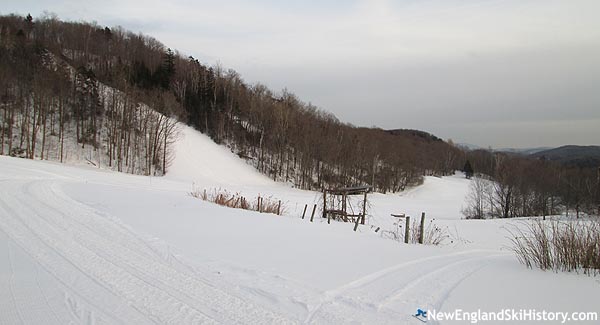
|
| Sonnenberg |
| Barnard, Vermont |
| Status: |
Lost/Defunct
|
| First Season: | 1967-68 |
| Last Season: | 2000s |
| Vertical Drop: | 500 feet |
| Standing Lifts: | |
| Past Lifts: | Surface lifts |
| Left: Twin Farms ski area (2014) |
| Recent NewEnglandSkiIndustry.com News:
|
|
Located east of Route 12 in Barnard, Twin Farms is an elite resort that was developed around the former Sonnenberg ski area.
Twin Farms, Sinclair Lewis, and Dorothy Thompson
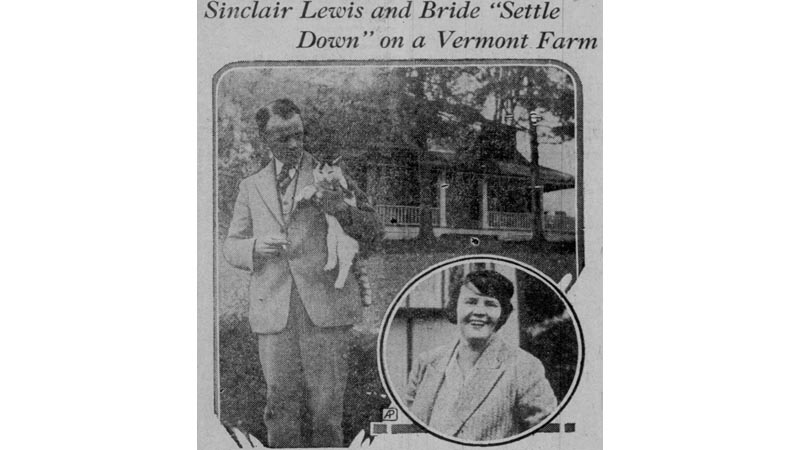
Sinclair Lewis and Dorothy Thompson circa 1928 |
The development that became known as Twin Farms and Sonnenberg dates back to the late 1700s, when a farm house was constructed in Barnard, Vermont. The farm eventually became owned by Louis Connett.
In 1928, a famous novelist became engaged to a famous political columnist. After Sinclair Lewis married Dorothy Thompson, the couple acquired the 300-acre Connett property for a reported $10,000 or $15,000. The couple moved to the remote farm without electricity in September 1928, attracting coverage of newspapers across the country. Some speculated that Lewis had chosen the remote town to research for his next novel, while local papers such as the Burlington Free Press noted that, "a large number of people from New York State seem to be coming in and buying up land for summer homes."
In September 1929, Sinclair Lewis told the Rutland Rotary Club, "I have come to Vermont, because it is quiet, because you have a population not driven by that American mania 'terrific speed to make things grow.'" Weeks later, word emerged that Lewis and Thompson had dubbed their property, featuring the historic house and guest house, "Twin Farms."
The famous couple eventually drifted apart, as Thompson filed for divorce in November 1941. The divorce was granted in January 1942 and Thompson retained Twin Farms. Months later, a prominent Czech painter named Maxim Kopf was hired to paint Thompson's portrait at the property. The two were married at Barnard Universalist Church June 15 1943, with the reception following at Twin Farms.
After years at Twin Farms, the couple began to downsize, selling the core 460 acre property to William Reynolds Albertini of Sea Island, Georgia in October 1957. Maxim Kopf passed away in July 1958. Dorothy Thompson retained 70 acres and a home in Barnard, passing away in February 1961.
Sonnenberg
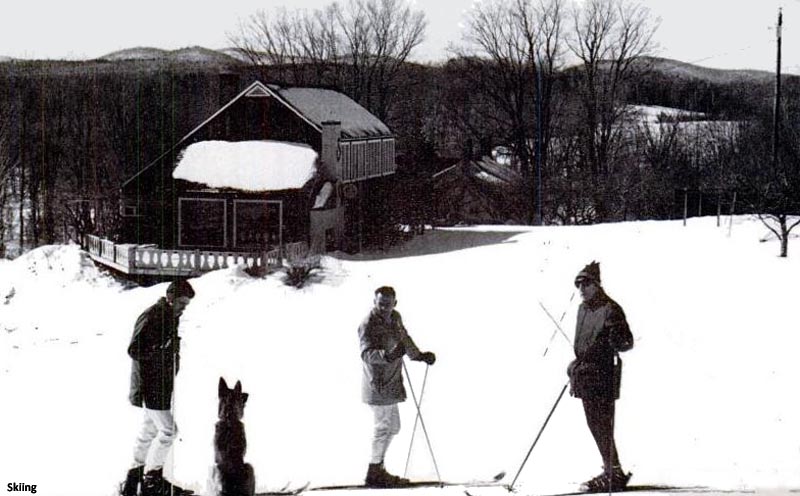
Sonnenberg circa the late 1960s |
Circa 1966, Hans Kurash, a residential builder from Pennsylvania, reportedly acquired a 400-acre tract of Twin Farms. The house was operated as an inn during the winter of 1966-67 while plans were made to develop a four-season resort. Sonnenberg, German for "sunny mountain," was selected as the name.
Hans and his son Ralph reportedly designed and cleared ski trails and house lots in the spring of 1967 and made plans to convert Maxim Kopf's former art studio into a base lodge. Other planned attractions for the resort included horses and trout ponds.
Word of the new ski area hit New England publications that fall, with Sonnenberg advertising a no lift line guarantee, even boasting, "we will cheerfully refund your money." The long-term plan for the ski area was to go private once 100 housing lots had been sold.
Located on 10 minutes from Suicide Six and 15 minutes from Mt. Tom, Sonnenberg's six miles of trails and 2 Pomalifts were open by January 1968. The most challenging trails were said to be Grossweg and Spassweg.
Numerous weddings were held at the growing resort during the 1968 off-season.
Operations were listed as six days per week for the 1969-70 season, offering 10 trails on a vertical drop of 500 feet.
A new dining room was added to the Sonnenberg Haus in 1972. Previously only serving inn guests, the added space resulted in the dining room opening to the general public.
The Twigg-Smith Family Acquires Sonnenberg
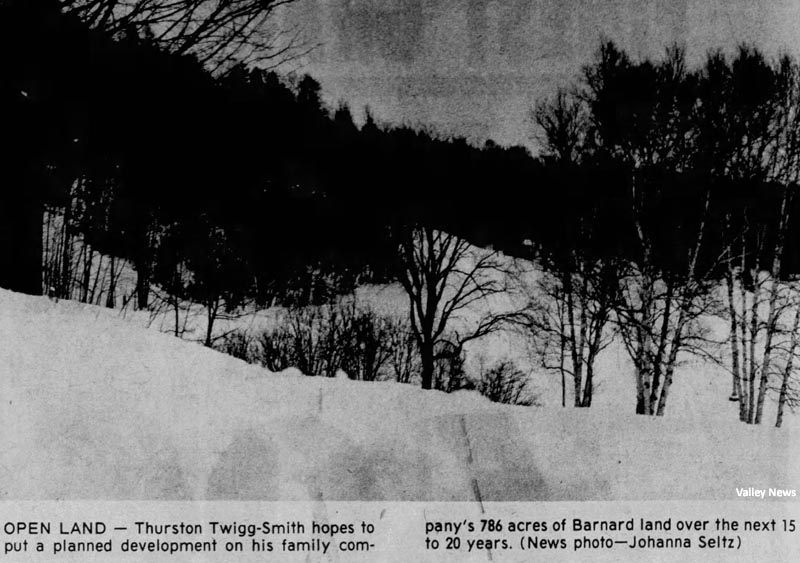
The tract circa the mid 1970s |
In May 1973, word emerged that Hans Kurash had agreed to sell the Sonnenberg property, including the ski area and remaining acreage that hadn't been developed, to Thurston Twigg-Smith. Owner of the Honolulu Advertiser, Twigg-Smith and his company ASA Properties Inc. had been acquiring land in Vermont since 1970, including tracts adjacent to Mt. Ascutney and Suicide Six, as well as the Barnard General Store. Twigg-Smith's son Thurston "Koke" Twigg-Smith Jr. settled in Barnard with his young family after graduating from Cornell, telling the Valley News that the land was acquired because "the corporation in Honolulu is set up so excess capital has to be invested" and that his mother's family was from New England. In 1972, Koke Twigg-Smith told the Valley News, "We don't like developments and think it's a bad word, too. We wouldn't like to see things start which destroy the atmosphere of this town."
At the time of the 1973 acquisition, Koke Twigg-Smith told the Valley News that, "I don't think they'll [sic] be any noticeable change" with Sonnenberg, noting that Kurash had approached them, and would be staying on as president of Sonnenberg, Inc. for the next year.
In the fall of 1974, word emerged that Twigg-Smith was planning to build up to 200 residential units on 800 acres of land in Barnard. Koke Twigg-Smith told the Valley News that the units of varying sizes would be built over multiple decades, forming a recreational community, but not on the scale of nearby Quechee.
Twigg-Smith presented development plans to residents in Barnard in January 1975, consisting of 175 units on 786 acres. 500 of the acres were to remain open for recreation, including tennis courts, swimming ponds, 12 miles of trails, equine activities, and another ski area. Twigg-Smith commented that if the plans did not move forward, he would likely sell the land, adding, "I'd rather see no development than development, but the practicalities are that people in Vermont are selling the land and have to expect it'll be developed. We're trying to make the best of an inevitable situation."
Thurston Twigg-Smith and Koke Twigg-Smith met with the town's planning commission in September 1975 as the project grew to 190 cluster units on 854 acres, with the Sonnenberg ski area serving as the focal point. An October meeting drew some local pushback, leaving Koke Twigg-Smith to lament, "We tried to present everything we had in mind and all of a sudden it becomes the big bugaboo." The company pulled the proposal in November.
ASA Properties resubmitted a scaled back 135-unit, 560-acre plan in January 1976, which was approved by the town in April.
Ski magazine had a brief write up about Sonnenberg in February 1977, noting, "Taste and wealth are both in evidence - from the 17 surrounding luxury homes to the private five-acre spring-fed lake and tennis courts below. Not surprisingly, the clientele is heavy with retired corporation presidents and their families, not to mention TV sports commentator Jim McKay." The writer added, "there's a choice between easy gliding by some of Sonnenberg's beautiful homes or some fairly steep, moguled trail skiing. Narrow chutes or elbows on several of the five trails keep things interesting. A sixth trail is used for touring."
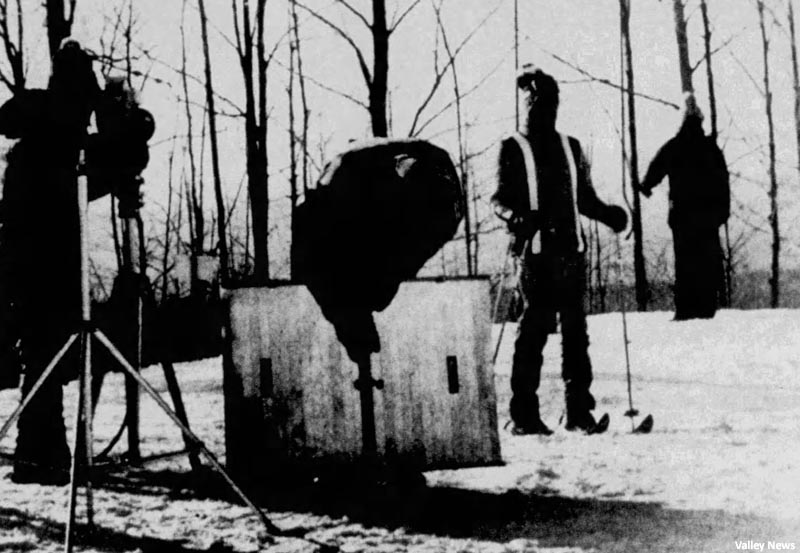
Val DuFour filming Search for Tomorrow at Sonnenberg (January 1978) |
In January 1978, CBS rented the ski area for a week to film scenes for the long-running soap opera Search for Tomorrow. Free skiing was provided in order to attract extras. Though the initial shoot was hampered by a downpour, the $100,000 filming took place two days later. Actor Val DuFour was said to have struggled from a lack of skiing experience, while co-star Marie Cheatham had no issues due to being an experienced skier.
Despite gaining local approval for the real estate development, the Ottauquechee Regional Planning Commission rejected the Sonnenberg proposal in February 1978, triggering Vermont Act 250 questions. The District 3 Environmental Commission eventually sided with the Barnard Planning Commission, granting Act 250 approval in April for a 510-acre subdivision with 82 lots. One year later, the approved project was reportedly offered for sale at a price of $1 million.
Sonnenberg was unable to avoid the impacts of the devastating winter of 1979-80. At Christmas time, Jim Mills told the Burlington Free Press, "Looking outside, I can't even see a patch of snow," adding, "Every day we're closed we lose one-50th of our whole season. What can you do?" It is not known if the ski area operated that winter.
Word of a possible sale emerged in the winter of 1980-81. According to the Rutland Daily Herald, an out-of-state developer made an offer to acquire Sonnenberg and execute the development plan. The sale was reportedly postponed when a local group expressed interest in acquiring and conserving the property.
The winter of 1980-81 was another struggle, as Sonnenberg only operated 20 days. As a result, the ticket price was cut by a third to $6 for the 1981-82 season. Manager Steve Cota told the Valley News, "For $6 it sounds like a good deal and people are trying us. We've got a real mountain here and people don't realize that."
The lower ticket prices reportedly helped get Sonnenberg back in the black for the first time in nearly a decade, including a strong Christmas week and a February day with 260 tickets sold. Manager Steve Cota noted that the area hadn't had a good snow year since 1973, adding, "Since then we've just been coasting."
Meanwhile, in November 1981, ASA Properties sold 610 acres and the rights to the 82 approved development lots to William J. Martin and Raymond Ankner for $1.475 million. The Twigg-Smiths retained the Sonnenberg ski area.
After a poor showing with only 847 tickets sold in 1984-85, sales grew to 3,324 for the 1985-86 season. Sonnenberg operated an additional 6 days during the 1986-87 season, however ticket sales dropped by 12%. Growing insurance premiums added extra pressure to the financial situation.
Near Closure
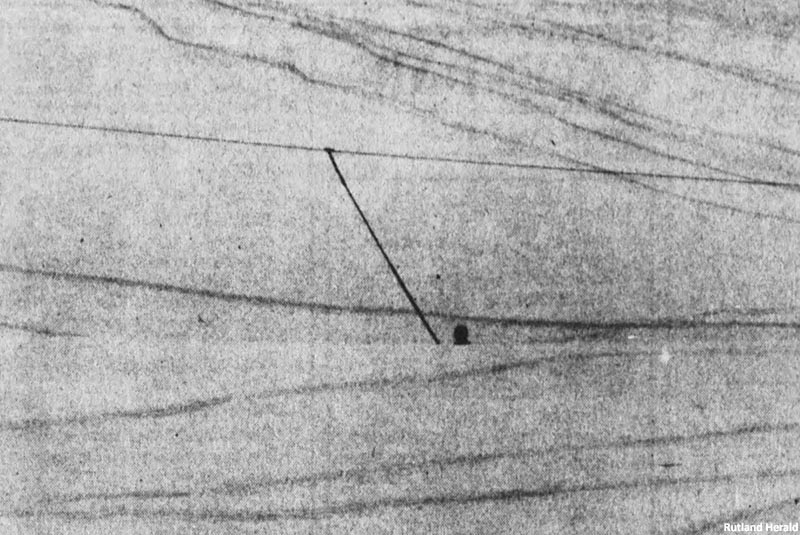
A Pomalift rider (1988) |
In October, Koke and Andrea Twigg-Smith announced plans to shut down the ski area. Reflecting on the situation, Twigg-Smith told the Burlington Free Press, "It's always just gotten by. My wife and I decided we couldn't stay on the way it was going."
The historic farmhouse, which had stayed in the Lewis family, burned to the ground early in the morning on November 13, 1987. Only the brick chimney was left standing from the late 1700s structure.
Five people purchased shares in the ski area and Twigg-Smith agreed to manage it for one more season. Dean LeBaron, a Boston investment manager, became the principal shareholder. Changing its operating model, Sonnenberg tripled its lift ticket rate to $45 for the 1987-88 season, the highest in New England. The price included rentals, lessons, food, and beverage (including beer and wine), with capacity was capped at 100 people. LaBaron told the Rutland Daily Herald, "There really was no alternative. It was clear after eight to 10 years that Sonnenberg was not making it as a business, so we had to change things." LeBaron also noted that the ski area was for sale.
Sonnenberg reportedly averaged 50 skiers a day with the new pricing, drawing some first-timers with the all-inclusive package. Break-even was estimated at 67 skiers. One disadvantage was noted by Andrea Twigg-Smith: "I feel very bad about not having the kids here this year. We always tried to make this a family-oriented area."
John and Virginia Lancaster served as co-managers for the 1988-89 season. Unfortunately, a lack of natural snow kept the area closed that winter. John Lancaster told the Valley News, "It's up to our board of directors now."
The area did manage to operate during the 1989-90 season, but a lack of snow resulted in only eight weekends of skiing. Virginia Lancaster told the Valley News that the plans were being developed to reopen the Sonnenberg Inn, expand nordic skiing, and install snowmaking on the downhill ski area.
Koke Twigg-Smith returned as manager for the 1990-91 season and ended the $45 ticket, noting, "I knew it was going to alienate the local skiers," adding, "The backer was willing to subsidize his program for three years. Three years have passed and we're back to doing our own ideas."
Following the poor winter of 1990-91, Sonnenberg's base lodge hosted Barnard's second and third grade classes for the balance of 1991 while Barnard Central School was renovated and expanded.
It is not known if the ski area operated during the winter of 1991-92. The novice lift was reportedly removed in the spring of 1992 to make way for a garden.
Sonnenberg Becomes Twin Farms
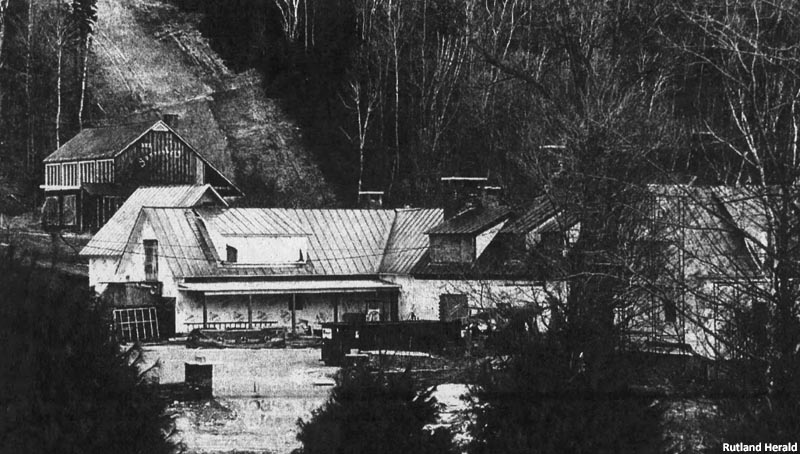
Twin Farms (1993) |
As Sonnenberg faded away, plans were being developed to convert the property into a $10 million luxury resort named Twin Farms. In January 1993 Thurston Twigg-Smith told the Rutland Herald that, "we've given up waiting for snow and turned the property into an inn," adding, "The ski area is going completely off the public maps and will only be for inn guests in the future."
The upscale Twin Farms Resort opened in the fall of 1993, featuring four guest suites in the inn, two in the former ski lodge, and three cottages. Shaun and Beverley Matthews served as managers. By this point, the resort comprised 235 acres and was operated by the Twigg-Smith family's Persis Corp. Twin Farms quickly became nationally known as a luxury destination, attracting prominent guests with its lavish offerings and gated anonymity.
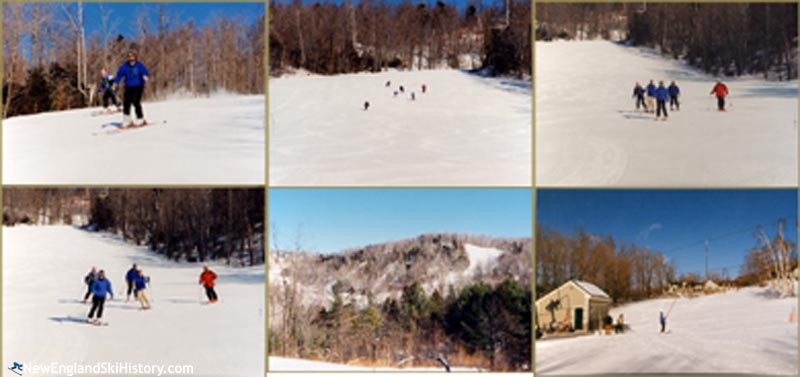
Skiing at Twin Farms circa the early 2000s |
Circa March 2002, Twin Farms was sold by Persis Corp. to Twin Farms Collection. Owners of Twin Farms Collection included Thurston Twigg-Smith and his daughter Evelyn Twigg-Smith. The group pressed forward with plans to construct a similar type of resort in Sonoma, California to be called Timber Hill.
The remaining Pomalift was likely taken out of service at some point between 2005 and 2012. Groomed downhill skiing continued to be provided, subsequently served by snowmobile.
Sonnenberg founder Hans Kurash passed away on April 9, 2015 at the age of 90. Thurston Twigg-Smith passed away on July 16, 2016 at the age of 94.
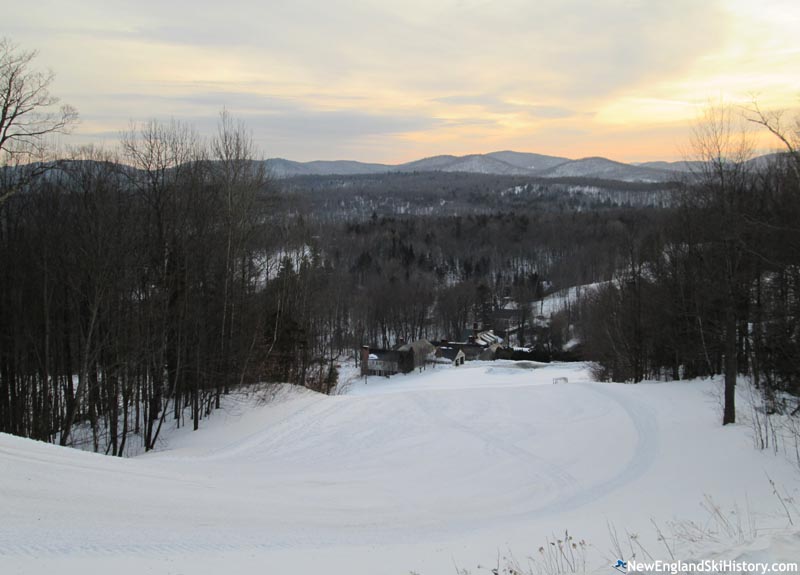
Trail 1 (March 2014) |
Twin Farms continues to be a year-round resort, offering downhill skiing to guests on six groomed trails when natural snowfall allows. As of 2022, a UTV with tracks is used to transport skiers to the top.
Lifts
Click on lift name for information and photos
Maps
Year by Year History
Adult Weekend Full Day Lift Ticket; Adult Full Price Unlimited Season Pass. Window price, including RFID fee and taxes when known.
| 1990s |
Ticket Price |
Season Pass Price |
Pass Payback |
Opening Day |
Closing Day |
Skier Visits |
| 1989-90 | $45.00 |  | |  | | | | |  | |
| 1980s |
Ticket Price |
Season Pass Price |
Pass Payback |
Opening Day |
Closing Day |
Skier Visits |
| 1987-88 | $45.00 |  | |  | | December 19 | | |  | | | 1986-87 | $15.00 |  | |  | | | | |  | | | 1985-86 | $10.00 |  | |  | | December 21 | | |  | | | 1984-85 | $8.00 |  | |  | | | | |  | | | 1983-84 | $8.00 |  | $96.00 |  | 12.0 days | December 23 | | |  | | | 1981-82 | $6.00 |  | |  | | | March 28 | |  | | | 1980-81 | $9.00 |  | |  | | | | |  | |
| 1970s |
Ticket Price |
Season Pass Price |
Pass Payback |
Opening Day |
Closing Day |
Skier Visits |
| 1978-79 | |  | |  | | | March 18 | |  | | | 1976-77 | $7.00 |  | |  | | | | |  | | | 1975-76 | $6.00 |  | |  | | | | |  | | | 1971-72 | $5.00 |  | |  | | | | |  | | | 1969-70 | $4.00 |  | $60.00 |  | 15.0 days | | | |  | |
| 1960s |
Ticket Price |
Season Pass Price |
Pass Payback |
Opening Day |
Closing Day |
Skier Visits |
| 1968-69 | $4.00 |  | $70.00 |  | 17.5 days | | | |  | | | 1967-68 | |  | $60.00 |  | | | | |  | |
Visitor Memories
| "My parents and Marjorie and Hans Kurash were friends and neighbors having lived on the same street in Pennsylvania in 1949 in Sugartown, near West Chester. Ralph and I were friend growing up. The Kurashes goal was to move to Vermont and open a ski area by the time they were 40. The missed it be a year. They were 41 when they bought the property. We would go there once or twice a year and went there between Christmas and New Year every year during the late '60s and early '70s. Ralph was an excellent skier. Jim McKay was friendly with Jean Claude Keeley and brought him to Sonnenberg one winter. Keeley watched Ralph ski a said, "He's the best skier I've ever seen, including me!" This is according to what I was told by my father who had become friendly with Jim McKay after spending some time with him at Sonnenberg. I'll stop here for now but could go on. The times we went to Sonnenberg were the best days of my young life. I met Jim McKay, Elliot Gant (Gant Shirts) and Byron Thomas, a local painter of some renown and generally had great times there. I even tended bar the first night the Inn was open for dinner. What a place!" | | Edward N. Flail Jr, Oct. 1, 2025 | | "Skied here extensively in the late 60’s and 70’s with my cousin that lived in Woodstock. Great family memories of parents bringing us and releasing us for the day to catch up at the lodge for lunch. Remember seeing Jim McKay skiing there as he had a home next to there. Loved it!" | | Peter Konstantino, Sep. 27, 2025 | | "Learned to ski at sonnenberg-As a Child, my parents owned a nice little house in Bethel Vt
and purchases season tickets for all us Boys, and left me with Great Memories" | | Matthew Mannix, Jan. 11, 2025 | | "I skied there with a friend of Dean LeBaron in the early 90s --- such a beautiful, friendly, family-oriented spot! I learned to ski moguls by following teenage boys down the hill!" | | Marcia Polese, Feb. 24, 2024 |
|
External Links
Twin Farms - official site
|
Last updated: October 3, 2023
|



